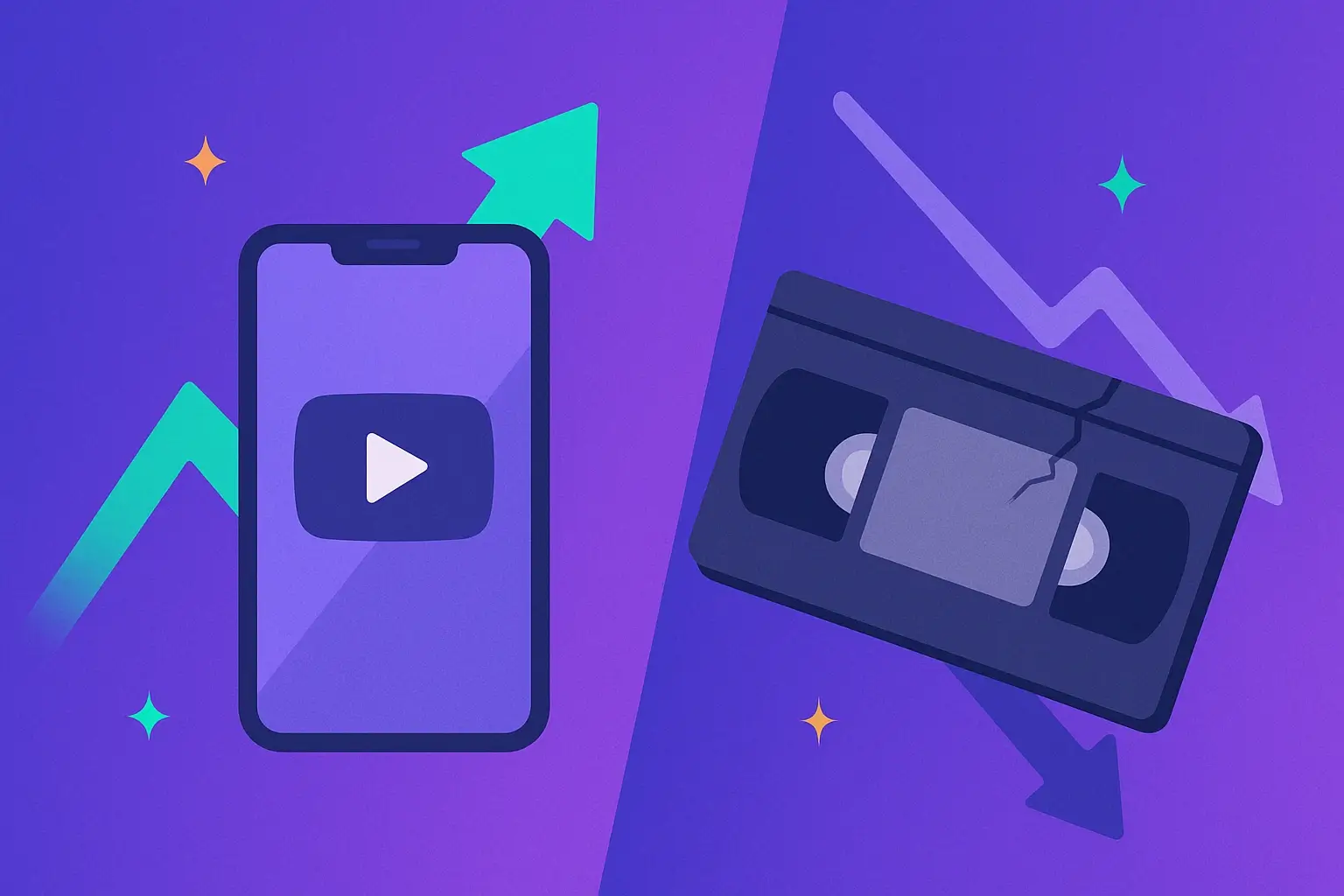Table Of Content
It’s wild how fast video has taken over the marketing world. A few years ago, it was just something nice to have on your homepage or maybe a “meet the team” clip buried somewhere.
Now, video is the first thing people look at. It’s how they discover your brand, how they learn about your product, and often how they decide whether to trust you or not.
Many businesses go from silent and forgettable to memorable and trusted just by putting a solid video strategy in place. Whether you're a startup trying to explain your product or an established company building brand loyalty, video can do some heavy lifting
So, if you’ve been wondering what all the fuss is about or you're just not sure where to start, you’re in the right place. I’ve broken it all down in this guide. Stick around, it’s all here.
What Is Video Marketing?
In simple words, video marketing is using video content to reach, engage to grab attention, explain things clearly, and connect with your audience. It's everything from 6-second TikToks to hour-long YouTube tutorials.
Product demos, behind-the-scenes content, live streams, shoppable ads, educational videos, brand stories. The list goes on.
However, most people think video marketing is simply about creating videos. Nope. It's about creating content that drives real business results.
According to video marketing statistics, 85% of businesses have adopted video marketing in their strategies. That's everyone except your uncle's plumbing business (and even he's probably on TikTok by now).
How Does Video Marketing Work?
Video marketing works by using video content to attract, engage, and convert your target audience throughout their buying journey. It combines storytelling, education, and promotion to deliver messages that are more memorable and persuasive than just text or static images.

The reality includes countless format and platform decisions, audience targeting considerations, and optimization strategies.
What makes video so effective is its versatility. You can create awareness with entertaining short-form clips, build trust with educational content, showcase products with demos, or close sales with testimonials.
Why Video Still Dominates in 2025 (But Not Like Before)
Video dominates marketing for simple biological reasons. Our brains are literally wired to process visual information 60,000 times faster than text.
When you combine that with motion and sound, you have the most powerful communication tool ever invented.
Back in the day, video was the shiny new thing. I remember in 2021 when simply posting any video content would guarantee decent engagement. Those days are long gone.
Today, people want to get something out of what they’re watching. Help, insight, clarity, and a real face behind a product. That’s why silent ads, intros, and generic stock footage don’t cut it anymore.
What's Working Now in Video Marketing
Forget everything you think you know about video marketing. The tactics that worked two years ago are now radioactive. I've been testing new approaches with dozens of clients over the past year. Here's what's moving the needle in 2025.
Micro-Content with Context
Everyone's obsessed with short videos, but they're missing the secret ingredient: context. Sure, 58% of viewers watch videos under 60 seconds to completion. But random short clips perform worse than ever because everyone's making them now.
I worked with a fitness brand that was struggling with its 30-second workout clips. Each video got decent views but zero engagement. We shifted strategy completely.
Instead of random exercises, we created "The 7-Day Challenge" series. Seven 15-second videos, each building on the previous one. Day 1 was basic squats. Day 7 was a complex movement combining all previous days.
Next time, try this approach: Take your next big idea and slice it into 5-7 connected micro-videos. Release them over a week. Watch engagement compounds as people follow the story.
AI-Generated Videos
According to statistics, 69% of Fortune 500 companies use AI-generated videos for brand storytelling and marketing. However, I noticed that brands are pumping out generic AI videos that all look identical.
Same robotic voiceovers, same stock footage style, same boring transitions.
The brands crushing it with AI are using it as a creative amplifier, not a replacement.
Last month, I helped a B2B software company create 50 personalized demo videos in one afternoon. Not generic demos; personalized ones.
We fed their customer success stories into Zebracat along with specific industry pain points. The AI-generated custom demos show how their software solved each industry's unique problems.
We recorded the founder's voice once, explaining the core value proposition. Then, create the voice clone using Zebracat to create multiple videos.
Indeed, businesses actively use AI in video production now. But most are using it for basic stuff like auto-captions. The real opportunity is creative scaling.
Try this: Record yourself explaining your core message once. Really well. Then use AI content creation tools to create multiple versions with different visuals, examples, and industry-specific details.
Voice + Subtitles = King
This might be the most misunderstood trend in video marketing right now. Everyone knows most videos play silently. So marketers think subtitles are enough.
Wrong. That's only half the equation.
Here's what I discovered after analyzing hundreds of our client videos: Vertical videos with quality audio see 12% higher conversion rates than silent ones.
I learned this lesson painfully with a client's product launch video. We spent weeks perfecting the visuals and subtitles. The video looked gorgeous, silently. But when people turned the sound on, the audio was an afterthought. Flat narration, no personality, zero energy.
Performance was mediocre until we re-recorded the entire voiceover. Same script, but delivered like we were talking to a friend, not reading a manual.
Engagement doubled overnight.
Adding quality captions boosts view time by 28%. But quality audio makes people turn their sound ON.
That's when real engagement happens. Always remember: Script for audio first. Make it conversational, energetic, and worth listening to. Then create subtitles that capture that energy in text.
Pro tip: Most brands get captions wrong. They use tiny fonts, boring colors, and no personality. Your captions should be as engaging as your audio. Bold fonts, brand colors, and even emojis when appropriate.
Instead, create two versions of your next video.
Version A: perfect visuals, boring audio.
Version B: great visuals, amazing audio.
Track which drives more actions, not just views.
Native-First Distribution
Platform algorithms are becoming more aggressive about keeping users on their platforms. Posting YouTube links on other social platforms is paying to lose reach.
But most brands go even more wrong with native distribution: They create one video and dump it everywhere. That's not native-first. That's lazy-first. Real native-first means creating platform-specific versions that feel like they belong.
I tested this with a client's product announcement. Instead of one video posted everywhere, we created five versions:
- LinkedIn version: 90 seconds, professional tone, focused on business impact.
- TikTok version: 30 seconds, trending audio, behind-the-scenes angle.
- Instagram version: 60 seconds, square format, lifestyle-focused.
- YouTube version: 5 minutes, deep technical details, searchable content.
- Twitter version: 15 seconds, text overlay heavy, quick insights.
Same core message. Completely different executions.
43% of businesses favor LinkedIn for video sharing, with YouTube at 40%. But they're not just posting the same content. They're tailoring for each platform's unique audience and format preferences.
The algorithm rewards content that keeps users on the platform. Native uploads get boosted. External links get buried.
Here's your action plan: Pick your next video idea. Instead of creating one version, create platform-specific versions from the start. Different lengths, different angles, different formats. Track which performs best where.
Educational Series Over One-Offs
Single educational videos are becoming white noise. Everyone's making them. Few stand out.
The format works across platforms. LinkedIn loves professional development series. Instagram Stories work for quick tip sequences. YouTube dominates long-form series.
One B2B client created "The 30-Day Marketing Transformation" series. 30 short videos, one tactical lesson each. By day 10, people were setting reminders for daily releases.
Sales conversations became easier because prospects had already consumed hours of their expertise. The key is making each episode valuable alone but better together. Like a good TV show.
What's Dead (Stop Wasting Time On These)
Not all video marketing tactics have stood the test of time. Here are the approaches that simply don't work anymore:

Explainer Videos That Feel Like School Lectures
You know the ones. A monotone narrator reading a script over boring slides. "Our revolutionary platform provides innovative solutions..."
44% of consumers cited short videos as their preferred method of learning about a new product or service. They want quick, engaging explainer videos. Not corporate lectures.
Replace lecture-style explainers with problem-solution narratives. Start with a relatable pain point your audience faces. Show the consequence of inaction within the first 5 seconds. Then demonstrate your solution in action, not theory.
Consider the "Show, Don't Tell" approach that splits explanations into micro-demonstrations. Instead of explaining how your project management software "streamlines workflows," show a 30-second clip of someone using it to solve a real deadline crisis.
Platform-native formats work better than traditional explainers. On TikTok, use the "POV" format where viewers experience your product from the user's perspective.
Long Intros and "Wait Till the End" Hooks
"Hey guys, welcome back to my channel. Today I'm going to show you..." SKIP.
Due to short attention spans, marketing videos need to grab viewers' attention in 2.7 seconds or less. Your intro IS your hook, make it count.
"Wait till the end for the big reveal!" is manipulation that backfires. Good content hooks people with value, not cheap tricks.
TikTok's data shows that videos placing their core message in the first 3 seconds achieve 13% higher ad recall than those that delay the reveal. The solution involves value-first opening strategies.
Lead with your strongest point, biggest benefit, or most surprising fact. Save brand elements for the middle or end when viewers are already engaged.
Use the "Cold Open" technique borrowed from television. Start mid-action or mid-conversation, then provide context.
Auto-Captions Without Editing
Auto-generated captions look like they were written by drunk robots. They hurt your credibility more than having no captions at all.
I see successful companies posting videos with captions that say "I love this piece of software" instead of "piece of software." It's embarrassing.
The bigger issue is missed optimization opportunities. Edited captions can be formatted for emphasis, include emojis for personality, and use strategic line breaks that match your video's pacing.
Develop caption editing workflows that go beyond error correction. Use font hierarchy by capitalizing key words or phrases.
Add strategic pauses with ellipses to create dramatic timing. Include relevant emojis that reinforce emotional beats without overwhelming the text.
Advanced caption strategies include calls-to-action embedded directly in the subtitle track. Instead of just transcribing speech, add prompts like "👆 Try this technique" or "🔗 Link in bio for full guide" at strategic moments.
Posting YouTube Links on Social Platforms
Cross-posting YouTube links to other social platforms creates an algorithmic death sentence for your content reach. Facebook reduces the organic reach of posts with external links by approximately 80% compared to native content.
This practice also creates a poor user experience. Viewers who click YouTube links on other platforms get redirected away from their current browsing session, creating friction that reduces completion rates and engagement.
The native-first approach requires creating platform-specific versions of the same core content.
A 10-minute YouTube tutorial becomes a 60-second Instagram Reel highlighting the key technique, a LinkedIn post with three essential tips, and a TikTok showing the before-and-after results.
Use teaser strategies that provide value while driving traffic. Create short native videos that teach one complete concept, then reference additional techniques available on your YouTube channel. This gives immediate value while encouraging platform switching.
When you must reference longer content, use storytelling bridging techniques. Tell a complete story in your native post, then mention that it's "part of a bigger guide" available elsewhere.
This satisfies the current platform while creating curiosity for additional content.
Relying Solely on Production Quality Over Story
High production value can't save a boring or irrelevant story. Some brands still think expensive cameras, perfect lighting, and slick editing will compensate for weak concepts.
But viewers increasingly prefer authentic storytelling over polished presentations that feel disconnected from real experiences. Consumers are 184% more likely to purchase after viewing user-generated videos compared to brand-produced content.
Flip your production priorities by starting with story structure before considering visual elements. Develop compelling character arcs, conflict resolution, and emotional payoffs. Only then, plan how to capture these elements visually.
Phone-shot authenticity beats studio polish when the story resonates. Focus budget on scripting, story development, and post-production editing rather than expensive cameras and lighting setups.
Test story effectiveness before investing in production. Create simple talking-head versions of your concepts using an AI video generator like Zebracat.
If the story doesn't work in this format, better production won't save it. If it does work, then you know where to invest additional resources.
Mass Video Emails Without Personalization
Generic video email blasts with "Check out our new video!" subject lines generate abysmal open and click rates. Video in email works incredibly well, but only when properly personalized and contextualized.
The most effective video email strategies now include:
- Recipient name in the subject line and email body
- Thumbnail images with play buttons that link to landing pages
- Content specifically relevant to the recipient's interests or behaviors
- Clear explanation of why this video matters to them specifically
- Video length indication so recipients know the time commitment
The goal shifts from reaching everyone to reaching the right people with the right message at the right time. Smaller, targeted videos often generate more revenue than large, generic distributions because they create genuine connections rather than broadcasting noise.
Platform-by-Platform Breakdown: What's Working in 2025
YouTube: Niche Depth, Not Mass Reach
YouTube remains the second-largest search engine, with more than 241.8 million people watching content in the US alone. However, the growth strategy has changed significantly.
In 2025, success on YouTube comes from depth in specific niches rather than broad appeal. The most successful growing channels focus on becoming the definitive resource in narrow topics rather than chasing general audiences.
What works now:
- Long-form educational content (10-20 minutes) with high information density
- Consistent series with predictable publishing schedules
- Comprehensive tutorials and how-to content
- Strategic keyword optimization in titles, descriptions, and tags
- Custom thumbnails with consistent branding
- Well-structured chapters for navigation
- Community engagement through comments and community posts
YouTube also remains the strongest platform for SEO benefits, as videos frequently appear in Google search results. Proper keyword research and optimization can drive significant organic traffic.
I've had the most success with YouTube by creating multiple videos on related topics that link to each other, creating a web of content that keeps viewers on my channel.
TikTok: Authority Through Value Loops
TikTok's growth continues, with US users spending an average of 58.4 minutes daily on the platform. The algorithm rewards creators who give viewers repeated reasons to engage.
Success on TikTok now comes from establishing topical authority through consistent, value-focused content rather than creating viral videos.
What works now:
- "Value loop" content that teaches a specific skill or shares a specific insight
- Multi-part series that encourages viewers to follow for more
- Strong hooks in the first 1-2 seconds
- Native features like duets, stitches, and video replies
- Trend participation with your unique twist
- Consistent posting (minimum 3-5 times weekly)
- Building recognizable content patterns that viewers come to expect
TikTok has also become a powerful product discovery platform. About 37% of Americans under 60 have purchased something via TikTok, with an average purchase of $59.
My most successful TikTok strategy has been creating a "knowledge series" where each video builds on previous content, creating a reason for viewers to follow and engage with the full series.
Instagram: Stories > Reels for Conversions
Instagram still boasts 2 billion users and remains strong for lifestyle and brand content. While Reels drive reach, Stories have become conversion powerhouses.
The platform has a bifurcated strategy: Reels for discovery and Stories for conversion and deeper engagement.
What works now on Instagram:
- Reels: Trend participation, educational micro-content, behind-the-scenes glimpses
- Stories: Interactive elements (polls, questions), time-limited offers, product tags
- Feed: Carousel posts with educational value, product highlights with multiple angles
- Lives: Product launches, Q&As, collaborations with influencers
Instagram's shoppable features make it particularly valuable for e-commerce brands. According to Sprout Social, 29% of Instagram users make purchases directly on the platform.
I've found that Stories consistently outperform other formats for driving traffic and conversions, while Reels excel at reaching new audiences. A balanced strategy uses both in tandem: Reels to attract new followers, Stories to convert them.
LinkedIn: Personal POV + B2B Wins
LinkedIn has become the #1 platform for B2B video marketing, with 70% of video marketers using it, surpassing Facebook for the first time.
Success on LinkedIn requires a different approach from other platforms, with emphasis on professional insights and business value.
What works now:
- Short (under 30 seconds) thought leadership clips
- Screen recording tutorials of useful processes
- Customer testimonial and case study videos
- Behind-the-scenes glimpses of company culture
- Industry analysis and trend breakdowns
- Personal stories with professional relevance
LinkedIn's algorithm favors native video uploads and penalizes external links. Videos should be formatted for mobile viewing (square or vertical) with captions, as most LinkedIn browsing happens during work hours when sound may be off.
X (formerly Twitter): Native Shorts with Threads
While smaller than other platforms for video, X still sees significant video consumption. More than 100 million X users watch vertical videos daily, and these videos make up 20% of all time spent on the platform.
X's video ecosystem works differently from other platforms, with an emphasis on brief, informative content.
What works now:
- Very short (under 15 seconds) videos with immediate value
- Thread-based video series (multiple videos in a single thread)
- News-focused and trending topic videos
- Reaction videos to current events
- Behind-the-scenes glimpses
- Quick tutorials and demonstrations
X's video strategy often works best when combined with text threads. A common effective approach is starting a thread with a short video hook, then expanding on the topic in subsequent text posts.
I've found X particularly effective for B2B thought leadership when using short video clips to introduce more detailed written content.
Pinterest Video Pins: A Rising Star in eCommerce
Pinterest continues to evolve as a video platform, with particular strength in the fashion, home, and recipe categories. Video Pins show higher engagement than static images, with about 3× the click-through rate.
What works now:
- Vertical format (9:16) optimized for mobile viewing
- Tutorial and how-to content showing products in use
- Shoppable video pins with product tags
- Seasonal and trending topic videos
- Series content organized into Pinterest boards
- Clear, text-based titles that explain the content
Pinterest's audience is highly purchase-oriented, making it particularly valuable for e-commerce. After watching a Pinterest video, users are 55% more likely to purchase the featured products.
One unique aspect of Pinterest is its longer content lifecycle. Trending content on Pinterest typically lasts 21% longer than on other platforms, making it valuable for evergreen product videos.
Facebook: Still Alive for Specific Demographics, But Only Native Uploads
Despite predictions of its demise, Facebook remains the largest social network, with over 2 billion people watching videos monthly. The platform skews older than TikTok and Instagram but remains valuable for specific demographics.
What works now:
- Native video uploads (never external links)
- Square format for feed videos, vertical for Reels
- Community-focused content (behind-the-scenes, company culture)
- Educational videos that solve specific problems
- Live videos for events, product launches, and Q&As
- Group-specific content that builds community
Facebook's algorithm heavily favors video content, with Reels receiving particular priority. Vertical videos with sound enabled see 12% higher conversion rates than other formats.
My Facebook strategy has shifted to using the platform primarily for community building rather than acquisition. Videos that showcase customers, answer common questions, or provide insider access perform best.
Here’s the blueprint I follow:
B2B vs. B2C: How Strategies Differ in 2025
B2B and B2C video marketing operate in completely different universes. The platforms, content styles, and success metrics couldn't be more opposite.
Platform Preferences Tell the Story
B2B marketers live on LinkedIn and YouTube. 86% focus their video efforts on LinkedIn because decision-makers hang out there. YouTube works for detailed demos and thought leadership content that builds long-term authority.
B2C brands dominate TikTok, Instagram, and Pinterest. 58% of Gen Z have TikTok profiles, and 45% actively follow brands there. The buying journey is shorter and more impulse-driven.
Content Length Reflects Audience Needs
B2B videos run longer because complex products need explanation. Think 1-3 minute demos, case study breakdowns, and educational series. Buyers need to justify purchases to bosses and committees.
B2C content stays short and snappy. Quick unboxings, lifestyle shots, and entertainment-focused clips perform best. 66% of consumers prefer short-form videos on social media.
Messaging Approaches Differ Completely
B2B content focuses on data, ROI, and problem-solving. Viewers want proof points, testimonials, and clear value propositions. The tone stays professional but increasingly personal.
B2C messaging targets emotions and entertainment. Joy, nostalgia, humor, and aspiration drive sharing and purchases. Authenticity beats authority every time.
The Funnel Moves Differently
B2B video supports a longer consideration process. Educational content builds trust over months. Lead capture and nurturing matter more than immediate conversions.
B2C video drives faster decisions. 29% of Instagram users make purchases directly on the platform. Stories with swipe-ups create immediate sales opportunities.
Budget Allocation Reflects Complexity
B2B brands invest more per video because each piece serves multiple stakeholders. A single demo video might influence 6-8 decision-makers over several months.
B2C brands create more videos with smaller individual budgets. Volume and frequency matter more than production value. User-generated content often outperforms professional productions.
Success Metrics Align with Goals
B2B tracks leads, pipeline influence, and sales cycle acceleration. 40% of B2B marketers call LinkedIn video their top lead generation source.
B2C measures engagement, shares, and direct conversions. Click-through rates and immediate purchases provide clear ROI data.
The Convergence Factor
Both strategies are evolving toward hybrid approaches. B2B audiences now expect entertainment value. B2C benefits from educational content that builds brand authority.
Smart brands create platform-specific versions of core messages. A tech product might get a fun TikTok tutorial for awareness and a detailed LinkedIn demo for decision-makers.

The key difference remains: B2B builds relationships while B2C captures moments. Your strategy should match your sales cycle and buying process accordingly.
The Role of AI in Video Marketing Now
AI is completely reshaping how videos get made. We've gone from needing entire production teams to creating professional videos from simple text prompts in minutes.
The numbers tell the story. 75% of marketers plan to use AI-powered video tools this year. That's up from basically zero in 2022. Currently, 18% of businesses actively use AI in video production, with another 66% eager to start.
The most common uses right now are auto-captioning (59% of companies), script assistance (50%), and automated video editing. But AI is solving the biggest pain points in video marketing.
Time constraints, high costs, and a lack of technical expertise used to block most teams from scaling video content. Not anymore.
Small teams can now compete with big budgets. A solo marketer can produce dozens of videos per week using AI tools that handle the heavy lifting.
However, I've tested dozens of AI video platforms over the past year, and most promise the world but deliver garbage. They generate a few seconds of raw footage and call it done. No music, no pacing, no real editing.
Others create videos that look AI-generated. Weird mouth movements, robotic voices, and generic stock footage that screams "automated content creation."
The biggest letdown is that tools that require you to learn complex interfaces just to get basic results. You end up spending more time figuring out the software than actually creating content.
Measurement in 2025: What Metrics Matter
Video marketing measurement has evolved beyond simple view counts to encompass engagement, conversion, and business impact metrics.
According to research, 66% of video marketers quantify ROI through engagement metrics like likes, shares, and reposts. 62% track video views, while 49% focus on leads and clicks.
Different types of videos warrant different primary metrics. Use this framework to align your video metrics with specific business objectives and calculate meaningful ROI.
Platform-specific metrics also matter. YouTube emphasizes watch time and subscriber growth, while TikTok prioritizes completion rate and shares.
I've found that creating a custom dashboard that combines metrics from different platforms provides the most comprehensive view of video performance. This allows for cross-platform comparison and better resource allocation.
One undervalued metric is "watch to action ratio"; the percentage of viewers who take a desired action after watching. This combines engagement and conversion metrics to show true business impact.
How to Audit Your Video Strategy?
Most video audits focus on vanity metrics and miss the strategic gaps that matter. A proper audit reveals why your videos aren't driving business results and what to fix first.

Start with Content Archaeology
Catalog every video you've published in the last 12 months. Not just the successful ones. Include the forgotten videos collecting digital dust on your YouTube channel.
Organize by platform, format, topic, and business goal. This reveals patterns you probably didn't notice. You might discover you've created 50 product demos but zero customer success stories.
Delete or privatize underperforming content that dilutes your brand. Videos with completion rates below 25% actively hurt your algorithmic performance on most platforms.
Analyze Performance Beyond Views
Views lie. Focus on engagement rate, watch time, and conversion metrics that tie to revenue. A video with 1,000 engaged viewers beats 10,000 passive scrollers every time.
Calculate your video-to-lead ratio. If 100 people watch your explainer video and only 2 fill out your contact form, you have a conversion problem, not a traffic problem.
Track platform-specific metrics that matter. Instagram cares about saves and shares. LinkedIn values comments and connection requests. YouTube rewards watch time and subscriber growth.
Benchmark Against Industry Standards
Compare your engagement rates to platform averages. TikTok should hit 2.5% engagement. Instagram posts average 0.5%. LinkedIn video posts should generate 20x more shares than other content types.
If you're consistently below these benchmarks, your content strategy needs fundamental changes, not just tweaks.
Research your top three competitors' video performance. Tools like Social Blade and VidIQ reveal their most successful content formats and topics.
Evaluate Platform Distribution Strategy
Count how many platforms you're using versus how many you think you're using. Many brands claim to be "on everything" but only post consistently to two platforms.
Review your native upload practices. If you're still cross-posting YouTube links to Facebook, you're sabotaging your reach.
Assess platform-specific optimization. Are your YouTube videos using proper tags and chapters? Do your TikToks include trending sounds? Are LinkedIn videos under 15 seconds?
Review Resource Allocation
Calculate the cost per video and cost per conversion. Most companies spend under $50K per video production, but many waste money on expensive videos that don't convert.
Audit your video content creation process timeline. If it takes six weeks to produce a simple explainer video, you need better workflows or different tools.
Evaluate team skills against content needs. You might be outsourcing video work that could be done faster and cheaper in-house with the right AI tools for content creation.
Test Current Content Assumptions
A/B testing reveals which elements drive performance. Test different thumbnails, titles, and opening hooks on identical content.
Run platform experiments. Post the same content natively to three platforms and measure which generates the most leads or sales.
Survey your audience directly. Ask what video topics they want to see next. The answers often surprise brands that've been guessing at audience interests.
Assess Competitive Positioning
Identify content gaps your competitors aren't filling. Maybe everyone in your industry makes product demos, but nobody creates customer onboarding videos.
Analyze competitor engagement patterns. Which of their videos generates the most comments? What topics drive shares? This reveals audience interests beyond your own performance data.
Look for format opportunities. If your industry only creates talking-head videos, animated B2B explainer videos might help you stand out.
Review Technical Infrastructure
Audit your video hosting and distribution setup. Are you using YouTube as free hosting for your website videos? That sends traffic away from your site.
Check loading speeds and mobile optimization. 75% of video consumption happens on mobile devices. Slow-loading videos kill conversion rates.
Evaluate your analytics setup. Can you track video views to actual sales? Most companies can't connect video performance to revenue because they haven't set up proper tracking.
Plan Strategic Pivots
Based on audit findings, identify your top three strategic changes. Maybe you need to shift from long-form to short-form content. Or focus on one platform instead of spreading thin across five.
Set specific, measurable goals for the next quarter. "Increase engagement" is useless. "Achieve 3% engagement rate on TikTok videos" gives you a target to hit.
Create content calendars that reflect audit insights. If customer testimonials perform 3x better than product demos, plan more testimonial content.
Document and Repeat
Video consumption trends change faster than any other content format. Quarterly audits keep your strategy aligned with platform changes and audience shifts.
Create audit templates that make the process repeatable. Future audits become faster and more thorough when you have systematic approaches.
The goal isn't perfect videos. It's strategic videos that drive business results. Your audit should reveal which content moves the needle and which just makes noise.
Create videos 10x faster and easier with Zebracat
Try it now







Comments